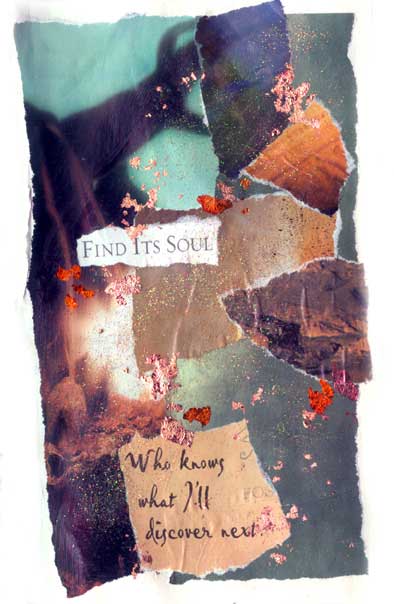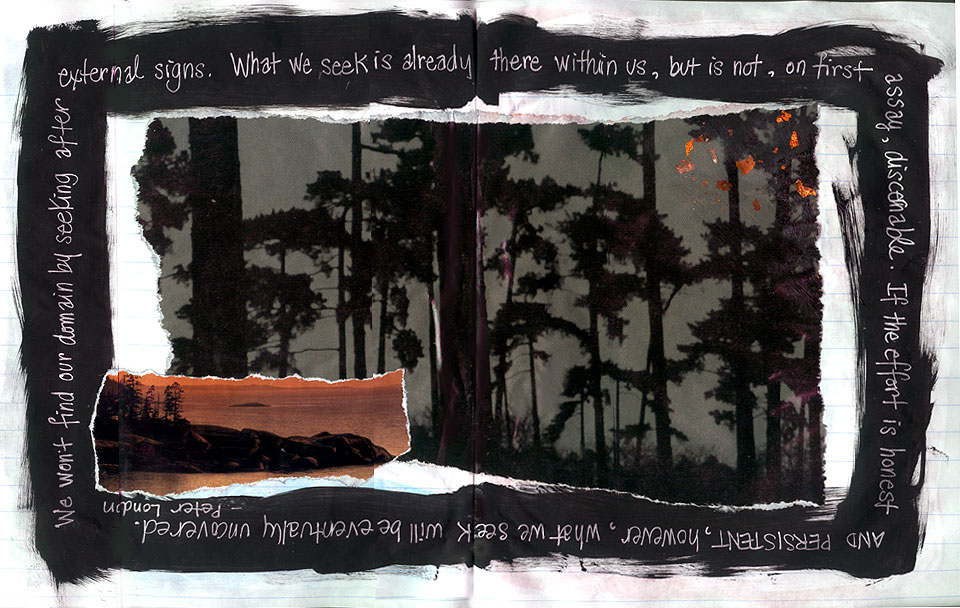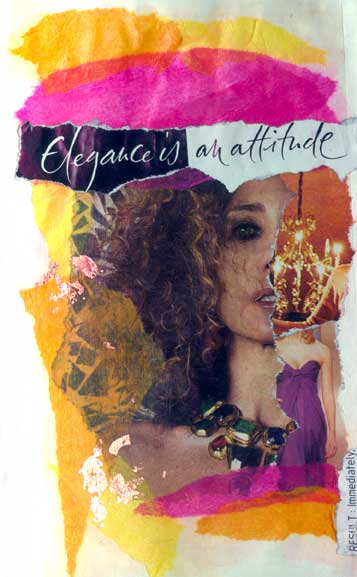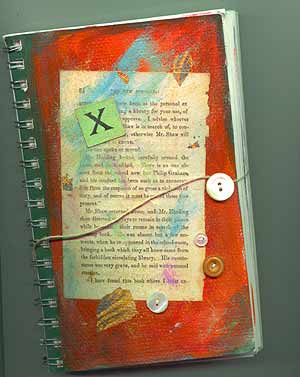
Collage is an easy way to add art to your diary or journal.
For years, I started each day with a quick torn-paper collage, the same as I used to create my handwritten “morning pages,” taught in The Artist’s Way: A Spiritual Path to Higher Creativity
Collages are a visual version of “morning pages.”
I wrote about my collage process in 2002, when I was the owner of the ArtistsJournals (and AJ2) Yahoo!Groups.
What follows is my 2008 update, as my art journaling process changed (slightly).
Most days, I allow an hour for each collage, and I try to create them in the morning, soon after I get up. That seems to be when my right-brain (creative side) is most active and open to imagery.
Sometimes – but not often – I go back several times throughout the day to add things.
Preparing the journal
Usually, I work on pages in a spiral-bound sketchbook, just as they are.
Sometimes I’ll gesso a few pages my journal, ahead of time. Then they’re strong enough to support heavily embellished collages.
That’s all gesso does: Make the page stronger, for embellishment, and – if you’re going to use paint – gesso prevents the paper from soaking up too much paint.
Most of the time, I don’t use gesso. I work directly on the paper.
Gesso
Remember that gesso is entirely optional. In fact, most people don’t use it at all.
I just like the option of adding paint or heavy embellishments to my art journaling pages. For that, gesso creates an ideal working surface in your sketchbook or other paper support.
I use any acrylic gesso that’s cheap, from any store that carries gesso. Michael’s can have some great deals, especially their house brand or as a student-grade product.
I buy the largest container they’re selling, for the best price.
Yes, you can buy gesso in colors, but if you start with white, you can add color to it, using dye, food coloring, or watercolors, or mixing in acrylic paint.
Now and then, I use black gesso for art journal pages on which I’ll stamp text in white, or use a white gel pen. Here’s an example.

For more information about gesso, see my other article, Gesso – What it is, how to use it
Photos, pictures, and other images
I store a variety of images – ad flyers, tickets, programmes, handwritten notes, vintage paper and photos (etc.) – in folders. For now, they’re kept in a heavy cardboard portfolio, to use when I want to create a collage.
In plastic bins, I store stack of magazines & newspapers, too.
(In addition, I keep a separate “junk bin” for junk mail flyers. I put those beneath my images as I’m applying glue to the back of the collage elements.)
I’ll grab whatever images, words, and phrases strike my fancy at that very moment.
If they connect somehow, great.
If they’re completely disrelated, that’s okay too. It usually makes sense to me after I put it all together, in the context of my thoughts at the time.
My favorite magazines for collage include the fashion magazine, W, because it includes great images, heavy paper, and very large words and phrases that show up nicely on my pages.
I also like glossy magazines such as National Geographic, because the colors are great, the images are unusual, and – since the pages are clay-based – I can use the magazine for image transfers.
(I’ll talk about that at another time. It’s a more complicated collage and embellishment technique.)
Gel medium
[As of 2021, some of the following information is outdated. I’ve stopped using gel medium for most of my art journaling collages. I’m getting far better results with Yes! Paste.]
I love layers in my work. For this reason, I’m very big on using colored tissue paper. I use Golden Gel Medium (soft/gloss) for the adhesive, and when the tissue paper is saturated with the gel medium, it remains translucent after it dries.
However, the gel medium will make the paper buckle sometimes. I like that, because I’m very process-oriented. I’m not interested in a collage that looks pre-printed.
The buckling and extra glops of gel medium work for me, but I know that not everyone likes the buckled-paper look.
I apply the gel with a sponge brush. I often forget to rinse them, so they’ll be used just once or twice, and I stock up on the cheapo ones (10 – 15 cents each during Michael’s store sales) regularly.
Wax paper keeps the pages from sticking
While the page dries, I’ll place a piece of waxed paper over it so I can turn the page and work on another page in my journal.
If the damp collage is facing another gel’d page, I’ll keep waxed paper between the pages for a week or two until the gel is fully cured.
Otherwise, the gel remains tacky enough to stick to the facing page.
For more about using wax paper when creating art, see my article,
Wax paper and art journals.
Other art journaling embellishments
I highlight some of my collages with leafing… gold, copper, etc. I adhere it with gel medium, too. Don’t get caught up in using the most/only perfect adhesive for the job; gel medium works well for almost anything.
When it won’t hold, I use Household Goop!

On a “hurting” day, a band-aid may hold an image in place. And there are grommets, paper clips, straight pins, safety pins, and so on. Look around you and see what might work for your collages. Give them texture. It can enhance the originality!
Most completed journals won’t fully close
 I never fret because an item means that the journal won’t close nice & flat.
I never fret because an item means that the journal won’t close nice & flat.
Frankly, by the time I complete lots of pages, my journal may be so thick – or so buckled – that it hasn’t a chance of closing flat, ever again!
I may sew a button to the front cover of the journal, and a piece of string (I like hemp twine) or ribbon attached with a grommet to the back cover, so I can tie the journal closed when I carry it around or shelve it.
Art journaling as self-discovery
These collages are exciting to me, because I never know how they’ll turn out until I start putting the random bits of paper together and realize what the internal message is. It’s sort of like bringing what’s deep inside me, forward.
But I love collage and I love journaling, and what I learn about myself and others in the process.
More? You’ll find additional notes on collage techniques in my Insight Shrines class handouts and in my letter to Erin about art/journaling.
Amazon and the Amazon logo are trademarks of Amazon.com, Inc, or its affiliates. As an Amazon Associate, I earn from qualifying purchases.